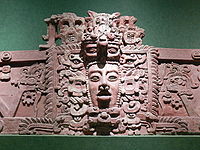- Cuello
-
Cuello Location Country:  Belize
BelizeRegion: Orange Walk District History First occupied: 1200 BC (Middle Preclassic) Excavation and maintenance Notable archaeologists: Norman Hammond Architecture Architectural styles: Preclassic Maya 
Maya civilization People · Languages · Society Religion · Mythology · Sacrifice Cities · Architecture · Calendar Stelae · Textiles · Trade Pre-Columbian Music · Writing History Preclassic Maya Classic Maya collapse Spanish conquest of Yucatán Spanish conquest of Guatemala Cuello is a Maya archaeological site in northern Belize. The site is that of a farming village with a long occupational history stretching back to approximately 1200 BC, during the Middle Preclassic period.[1] Its inhabitants lived in pole-and-thatch houses that were built on top of low plaster-coated platforms. The site contains residential groups clustered around central patios. It also features the remains of a steam bath dating to approximately 900 BC, making it the oldest steam bath found to date in the Maya lowlands. Human burials have been associated with the residential structures; the oldest have no surviving burial relics, but from 900 BC onwards, they were accompanied by offerings of ceramic vessels.[2]
Ceramics from the earliest phase of the settlement at Cuello belonged to an established lowland Maya pottery tradition, suggesting that the region was already settled by the Maya when the site was founded.[3] Although Cuello appears to have been a typical, relatively unimportant rural village in the Preclassic era, it participated in regional trade networks with obsidian being imported from the Maya highlands from 800 BC onwards, and a small amount of jade arriving in the community a few centuries later.[4]
Contents
Location
Cuello is located two miles Yo Creek Road in the Orange Walk District. It sits on the private land of the Cuello Family but permissions are granted to visit the site.
Archaeology
Uncorrected radiocarbon dates from the lowest stratigraphic levels of the site returned dates as far back as 2600 BC, although these were viewed as controversial.[5]
The site was investigated in the 1970s and 1980s by archaeologist Norman Hammond.[6] Structure 326 was excavated in 1980 and measures 8 by 4 metres (26 by 13 ft). The walls of the building were made of thin poles tied together with vines. This was then coated in a smoothed layer of clay and finished with a white lime wash.[7]
Archaeological investigation has revealed that the diet of the Preclassic occupants of Cuello consisted of less than 30% maize, compared with up to 75% for the modern Maya. White-tailed deer made up over half the meat in their diet, followed by freshwater turtles and domestic dogs, the last of which represents 7% of the animal remains found at the site.[8]
Burials
Two Late Preclassic mass burial areas have been uncovered at Cuello, one of which contained 26 or more males who had been sacrificed. Healed fractures on the bones suggest that they may have been captured warriors. Further evidence of local warfare comes from evidence of burnt buildings at the site.[9]
A number of elite burials have been excavated at Cuello. The earliest phases of the Middle Classic included both adults and children accompanied by offerings of jade and shell ornaments, indicating social differentiation.[10] High-status burials tended to be associated with specific locations throughout the history of the site.[10]
Burial 160 is an elite burial that has been dated to 500–400 BC.[10] It consists of an individual interred in a cist, accompanied by two ceramic vessels and ornaments that included tubes fashioned from deer bones and engraved with a mat design that in later times became associated with royalty.[10] There was also the upper portion of a human skull that had been fashioned into a plaque.[10] Due to these distinguishing features of the burial, the excavators concluded that it was that of a Middle Classic ruler of the settlement.[10] The site of this burial remained important in later times, with the residential patio being converted into a ceremonial platform upon which was built a small pyramid temple.[10]
Notes
- ^ Sharer & Traxler 2006, p.203. Drew 1999, p.127.
- ^ Sharer & Traxler 2006, p.203.
- ^ Hammond 2000, p.206.
- ^ Drew 1999, p.128.
- ^ Estrada-Belli 2011, p.38.
- ^ Drew 1999, p.127.
- ^ Hammond 2000, pp.206-207.
- ^ Sharer & Traxler 2006, p.163.
- ^ Sharer & Traxler 2006, pp.258-259.
- ^ a b c d e f g Estrada-Belli 2011, p.62.
References
-
- Drew, David (1999). The Lost Chronicles of the Maya Kings. London: Weidenfeld & Nicolson. ISBN 0-297-81699-3. OCLC 43401096.
- Estrada-Belli, Francisco (2011). The First Maya Civilization: Ritual and Power Before the Classic Period. Abingdon, Oxfordshire and New York: Routledge. ISBN 978-0-415-42994-8.
- Hammond, Norman (2000). "The Maya Lowlands: Pioneer Farmers to Merchant Princes". In Richard E.W. Adams and Murdo J. Macleod (eds.). The Cambridge History of the Native Peoples of the Americas, Vol. II: Mesoamerica, part 1. Cambridge, UK: Cambridge University Press. pp. 197–249. ISBN 0-521-35165-0. OCLC 33359444.
- Sharer, Robert J.; with Loa P. Traxler (2006). The Ancient Maya (6th (fully revised) ed.). Stanford, CA: Stanford University Press. ISBN 0-8047-4817-9. OCLC 57577446.
Categories:- Maya sites
- Maya sites in Belize
Wikimedia Foundation. 2010.

